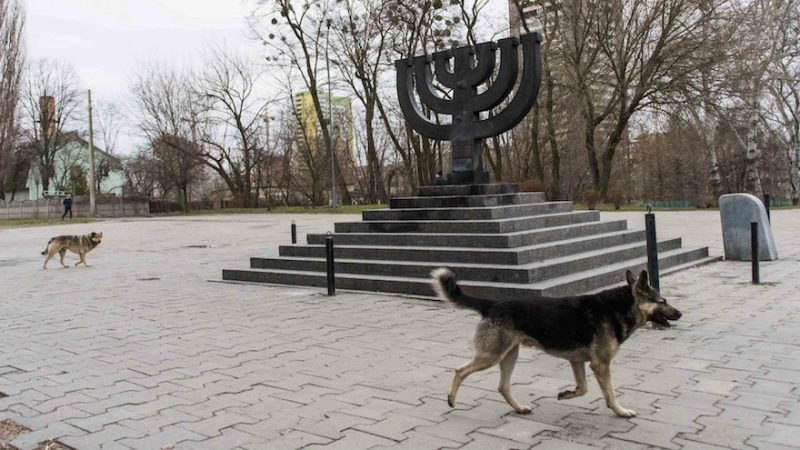“Do you really think we’ll get a proper monument? ”the 87-year-old Holocaust survivor, Vladimir Proch, asked the rabbi Yossi Azman. Proch lives near Babi Yar Park, the site of one of the most horrific of the Nazis’ crimes against the Jews. Proch has waited 15 years for the promised memorial. Jewish groups and tycoons have attempted to get something built to honor the Holocaust victims, but they have all failed to earn municipal support.
The current memorial is a large menorah that was placed as a temporary marker 25 years ago. The menorah is still charred from being torched – it has been attacked six times in the past year alone. It’s built near a construction waste dump and is frequented by homeless people and packs of stray dogs. There are swastikas on the entrances to the metro station nearest the park.
As the 75th anniversary of the largest massacres at Babi Yar approaches, though, authorities and community leaders are united in their determination to get a monument built. They are working to avoid the problems that plagued previous projects: funding issues, avoiding building over human remains and desecrating their graves, and feuds within Ukraine’s Jewish community.
Just last month, a new initiative began. Prime Minister Arseniy Yatsenyuk gathered a committee of officials and community representatives who meet every week. The goal is to build a monument by September 29, the anniversary of the day whenNazis started marching Jews from Kiev to the ravine on the outskirts of the city and massacring them with machine guns. Some estimate that 100,000 Jews, Roma, communists, and Soviet prisoners of war were killed at Babi Yar. The number includes over 33,000 Jews just on the first two days alone.
The current plan is for two paths to connect the menorah on the edge of the park with the park’s center. One path would commemorate the Jewish victims and the other would be dedicated to the Ukrainians who risked their lives to save Jews.
What will happen to the menorah is uncertain. The municipal government would like to see a stone wall integrated with replicas of items taken from victims before they were shot: spectacles, shoes, bags, etc.
“It’s just dignified enough to pass as decent,” said Moshe Azman, a Chabad rabbi from Kiev who is a claimant to the title of chief rabbi of Ukraine. “It’s not fancy, not huge, not spectacular – and that’s why it has a chance to succeed where previous plans failed,” he added.
Another chief rabbi of Ukraine, Rabbi DovBleich, said, “Any sort of halfway decent monument is better than the current reality at Babi Yar, which is just a disgrace.”
The design is estimated to cost only $150,000, a reflection of the economic reality in Ukraine. The country suffers from rampant unemployment and the national currency, the hyrvna, is now worth a third of what its value against the dollar was in 2014. The Ukrainian economy crashed that year when the government was toppled in a revolution that triggered the current armed conflict with Russian-backed separatists.
Several plans failed because they were too ambitious, Bleich said.
“In the current reality, but even before in a poor country like Ukraine, a $30 million to $40 million project is often just not viable,” he said. “It’s just not going to happen, or will take a long time to.”
There are currently three cornerstones at Babi Yar, each placed in anticipation of memorial projects that never happened.
In 2001, the American Jewish Joint Distribution Committee (JDC) wanted to build a Jewish community center near the actual gravesite. Religious Jews thought it improper while Jewish community leaders, meanwhile, complained that locals should build the center, not the JDC.
In 2006, Vadim Rabinovich, a businessman, and Jewish activist, proposed plans for a museum on land he bought near, but not on, the gravesites. Critics argued that the construction would disturb human remains and would be in violation of halachah, Jewish law. Meylakh Shoychet, the Ukraine director for the Union of Councils for Jews in the Former Soviet Union, and VitalyNachmanovich, the secretary of the Public Committee for Commemoration of the Victims of Babi Yar, were among the critics.
In an email, Nachmanovich insisted that he would continue to oppose plans to revive the museum project.Desecrating human remains is a common issue surrounding the Jewish mass graves and cemeteries in Europe. The halachic complications are particularly difficult because of the nature of the executions that occurred there.
After the first slaughter at Babi Yar, where the Nazis shot Jews who were lying down in layers on top of their dead brethren, smaller groups of Jews were executed and buried at the site from 1941 to 1943. The Nazis then exhumed and cremated the bodies and scattered the ashes to hide their crimes. It’s impossible to determine where the graves are located.
“The whole place needs to be treated like a cemetery because that’s what it is,”Shoychet said.
Bleich and Azman back the new design for this reason, too.
“It only entails placing tiles atop the ground, not digging in it,”Bleich said. “That defuses a lot of concerns.”
All victims at Babi Yar are commemorated with a massive monument built in 1976 for all “Soviet citizens” killed there. A monument specifically for Jews was not approved until after the Soviet Union fell.
Babi Yar is significant for Jews because it is the first massacre of its scale perpetrated during the Holocaust and the third or fourth largest overall. In a speech in 2006 given at the site, Meir Lau, a former chief Ashkenazi rabbi of Israel, described it as Hitler’s trial balloon for the Holocaust.
Had the international reaction to Babi Yar“been a serious one, a dramatic one, in September 1941 here in Ukraine,” Lau said, the fate of Europe’s Jews “would perhaps have come to a different end.”
